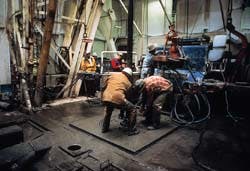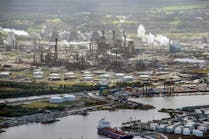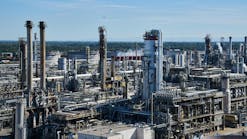Workers on the rig floor are drilling ahead on a well in Milne Point oil field, the BP Exploration (Alaska) Inc.-operated field that is emerging as the northernmost giant in North America. Photo courtesy BP.
BP Exploration (Alaska) Inc. is set to more than triple production and reserves of North America's northernmost oil development less than 3 years after becoming field operator.
BP and partner Oxy U.S.A. Inc. expect output of Alaska's Milne Point field to reach 65,000 b/d by yearend, a level that would place the field among the 10 most productive in the U.S.
Steady exploratory and development drilling efforts, including expansion of activity into new areas, have been the key to field production and reserves growth. BP has doubled the number of Milne Point wells the past 2 years and is maintaining a two-rig drilling program in the field.
Also, partners recently completed a $180 million project to expand capacity of Milne Point's oil processing facilities to 60,000 b/d from 30,000 b/d.
Production jump
Milne Point output in June surpassed 50,000 b/d, following completion of the 2 year expansion program.
Production comes from more than 150 production and injection wells on 12 gravel pads.
The stepped-up E&D efforts have prompted partners to jump estimates of Milne Point's original oil reserves to about 330 million bbl. The field has produced more than 50 million bbl of oil since its discovery in 1969.
When BP became Milne Point operator Jan. 1, 1994, field production averaged less than 20,000 b/d and reserves were estimated at slightly more than 100 million bbl.
Further increases possible
Milne Point's three productive oil-bearing formations-Triassic Sag River at about 9,000 ft, lower Cretaceous Kuparuk River sand at 7,000 ft, and upper Cretaceous Schrader Bluff at 4,000 ft-hold combined reserves estimates at 3 billion bbl.
If partners can overcome some persistent commercial and technical challenges, BP and Oxy by 2000 could drill as many as 300 more wells in the field, boost production to as much as 100,000 b/d, and add another 200-800 million bbl of reserves.
"Milne Point's growth is a tremendous tribute to BP's ability to see the potential of the area and our commitment to invest in that potential," said Howard Mayson, BP's Milne Point asset manager. "It's also testimony to the hard work and innovation of our staff and contractors to transform potential into production."
BP to date has invested more than $300 million at Milne Point and is contemplating plans for further investments of as much as $500 million.
Milne Point unit is a 71,000 acre tract on Alaska's North Slope about 35 miles northwest of Prudhoe Bay. The unit is bounded on the southeast by the northwest boundary of Prudhoe Bay unit and on the southwest by the northeast boundary of Kuparuk River unit.
BP holds 91.2% interest in the field and Oxy 8.8%.
Ramping up production
Wells at Milne Point require special equipment or techniques to enhance production.
For example, because of low reservoir temperatures, BP heats Schrader Bluff wells from surface to the base of permafrost to prevent freezing during production. Also, while most wells in the field flow under available reservoir pressure, about 70 use electrical submersible pumps to increase production rates.
About 25,000 b/d of Milne Point's net production gain since January 1994 comes from the northwestern part of the unit, where an appraisal drilling program in early 1994 confirmed reserves of more than 50 million bbl.
BP and Oxy by October expect to start production of Cascade discovery from K pad in the southeastern part of the field. Cascade output is to build to about 15,000 b/d by early 1997, and plans include drilling about 50 more wells to develop the Kuparuk River formation's oil reserves.
Partners on average are producing less than 2,000 b/d of oil from two Sag River wells and 3,500 b/d of oil from 19 Schrader Bluff wells.
The Kuparuk River formation is a high quality, tight sandstone that accounts for about a third of Milne Point's oil in place but more than 90% of field production.
Promise of Schrader Bluff
Schrader Bluff, the largest of Milne Point's three productive oil bearing formations, is the eastern extension of West Sak formation, which overlies Kuparuk River intervals in Kuparuk River unit.
Shallow, unconsolidated Schrader Bluff oil sands hold about 2 billion bbl of crude with gravities of 14-20°.
BP and Oxy last year drilled five Schrader Bluff wells from existing gravel pads to test new well designs and drilling techniques. They aimed to reduce costs and improve productivity of the formation's heavy, viscous crude.
Results were encouraging of a gravel packing program in Schrader Bluff wells that prevents granules from the formation's crumbly sands from entering the well bore, thereby lowering the risk of damaging production equipment. But significant challenges remain.
Early in 1996, BP embarked on a 5 year, $10.6 million joint study of the area with the U.S. Department of Energy's petroleum and energy research institute at Bartlesville, Okla., a facility now slated for privatization (see related story, p. 36).
Other companies at Milne Point and nearby Kuparuk River unit have spent more than $250 million trying to commercialize the shallow oil sands. BP says overcoming persistent commercial and technical challenges could add 200-800 million bbl of Schrader Bluff reserves.
Controlling development costs
Mayson says shortening the development timetable at Milne Point to cut the time between project funding and payback has been crucial to successfully competing for investment capital within parent British Petroleum plc.
For example, the recent project to expand oil processing capacity in the field was completed in less than 2 years, a fraction of the time that would have been required using traditional construction and development techniques.
"The entire project was done in an unconventional manner, from the way it was first sanctioned and through to completion," said Jim Bragg, BP production superintendent at Milne Point. "We broke a lot of stereotypes and unwritten rules, and we shaved considerable time off the schedule."
Rather than constructing modularized facilities in fabrication yards elsewhere, partners reduced development time and costs by building the expanded processing facilities on the North Slope. That move created more than 900 jobs at the peak of construction.
Some engineering, fabrication, and construction aspects of the processing expansion program occurred simultaneously. BP and Oxy also controlled costs by using some used equipment for the project.
Copyright 1996 Oil & Gas Journal. All Rights Reserved.



